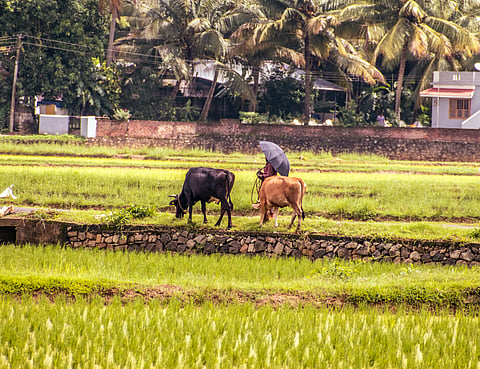
- Home
- EventsEvents
- Product Launches
- CategoriesCategories
- Advertise
- Opinion

Photo - aboodi vesakaran on Unsplash
India's leading rural insurtech startup 'Gramcover' and India's leading weather and agri analytics firm 'Skymet' have released The Kharif Crop Outlook report for 2021-22. The report highlights the monsoon performance, reservoir status, flood analysis, soil moisture assessment, normalized difference vegetation index, vegetation condition index, Kharif sowing progress and crop-wise analysis (cotton, soybean and pulses).
As per the data released by the Ministry of Agriculture on 2 September 2021, Kharif sowing stood at 1081.5 lakh hectares, about 1.14% lower this year compared to the corresponding period the previous year. The lower sowing across the country is attributed to the break in the monsoon after timely progress till it crossed Uttar Pradesh and afterward progress over Rajasthan was stalled.
As per Gramcover and Skymet's report, sowing of pulses is delayed in almost every state, but delayed sowing has no impact on productivity as Pulse's sowing continues till the end of August. As per the actual rainfall recorded till August and the forecast for September, productivity is likely to be good in all states. As per the current situation, the national average yield of pulses is expected to be around 702 kilograms per hectare, which is 14 kilograms per hectare higher than last year yield of 688 kilograms per hectare. Thus, pulses production is estimated to be around 10.24 million tons (14.60 million hectares), which will be around 10% higher than last year's Kharif production estimates of 9.31 million tons (13.51 million hectares).
Dhyanesh Bhatt, chief executive officer of Gramcover, said, "Overall, the country is in a moderate cropping condition which will improve as cropping is escalating towards vegetative condition from the sowing phase. The vegetative condition will improve with persistent precipitation and crop stage, leading towards the good vegetative condition. GramCover has worked with 4 lakh farmers in Kharif 2020, which spiked to 14 lakh plus in 2021 Kharif season."
He further added, "Prices of Soybean have more than doubled in the last marketing year. It is evident that farmers are desperate to sow soybeans on their farms. Water availability and pest attacks in the previous seasons have influenced the cotton sowing in the country. If the current trend continues, GramCover expects 5% lower acreages this year."
Yogesh Patil, chief executive officer of Skymet, said, "This year, the Agriculture Ministry has taken steps to promote the planting of pulses and oilseeds crops more than ever. Pulses sowing stood about 1.85% higher than the sowing during the same period the previous year. Cotton sowing too remained lower this year as of 2 September this year with a total area of 118.13 lakh hectares, about 6.58% lower as compared to the area of 126.45 lakh hectares sown previous year during the same period."
On the monsoon performance, the report highlights that the rainfall performance from 1 June till 9 September was subdued over the northeast and the western parts of India. The states, namely West Rajasthan, Gujarat, Jammu & Kashmir, Kerala, Odisha, Punjab, Nagaland, Manipur, Mizoram and Tripura, are rainfall deficient. Whereas Andhra Pradesh, Telangana, and Tamil Nadu have recorded excess rain. The rest of the states have received normal rainfall.
As per the updates released by Central Water Commission (CWC) on 2 Sept 2021, live storage available in these reservoirs stood at 111.691 BCM, which is 65% of these reservoirs' total live storage capacity collectively. Last year the live storage available in these reservoirs for the corresponding period was 140.051 BCM and the average of the last ten years' live storage as of mentioned date was 119.026 BCM. Hence as of 2 September this year, the live storage available in 130 reservoirs is 80% of the live storage of the corresponding period of last year and 94% of storage on average of the last ten years. The overall storage position is less than the corresponding period of last year in the country and is also less than the average storage of the last ten years during the corresponding period.
Soil Moisture Assessment in the report highlights that in the northern part of India, the Bihar state experiences marginally higher soil moisture in the present year as compared with the year 2020. Whereas Uttarakhand and Himachal Pradesh show a similar spatial pattern with the past year. For Punjab, Haryana, Uttar Pradesh and Jharkhand the soil moisture scenario is degraded in the present year as compared to the previous year due to monsoon characteristics.
